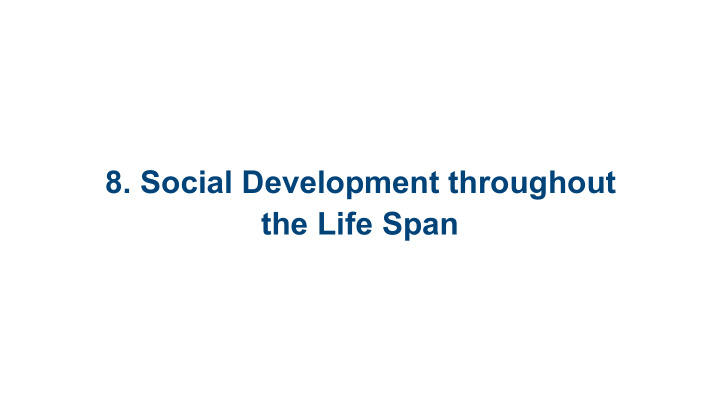



8. Social Development throughout the Life Span
8.1 Attachment 8.2 Self 8.3 Social Cognition 8.4 Social Learning and Modeling
8.5 Gender 8.6 Interpersonal Relationships 8.7 Moral Development
8.8 Prosocial Behavior 8.9 Risk and Resilience 8.10 Aggression 8.11 Wellness
8.1 Attachment
Infant bonding types • Secure: feels safe, cries when handed off • Insecure resistant: never assured; clings • Insecure-Avoidant: not assured, not clinging • Disorganized: not assured, reactions not consistent
Attachment findings • Harlow’s monkeys: infants least fear with “contact comfort” mother • Childcare not harmful to attachment unless poor quality
Attachment findings • Poor/lack of attachment ➔ psychopathic tendencies: dishonest, lack of empathy, cruelty, crime
8.2 Self
Know self, then others • Self-awareness 15 mo. • “Separation anxiety” • Sets stage for social emotions: guilt, shame, empathy, etc. in early childhood and beyond
8.3 Social Cognition
Self meets world • Social cognition: schemata about others • Toddler: “I want” and “Do myself” must balance with others’ needs • Early/middle childhood: inclusion of adults and authority outside family; peer group rising
Self meets world • Adolescent: peers as measure and validation • Young adult: new schemata as “junior” adult at work • Middle adult: growing authority with others • Late adult: relinquishing authority to others
8.4 Social Learning and Modeling
Cognitive learning theory • Learning by observing behavior and consequences (of adults, peers, etc.) • Early example: Social referencing = look to model to gauge how to feel/act • Later example: teen or young adult emulating role model
Bandura: vicarious learning • Direct modeling: adults and peers in environment • Symbolic modeling: TV, movies, celebrities, ads • Leads to skills, motivation, sense of self-efficacy • Danger of self-deception or unrealistic expectations
8.5 Gender
Identifying with gender • Gender as self- determined
Identifying with gender • Kohlberg’s stages of gender development • Gender identity 2-3 years (ability to label, but fluid) • Gender stability 3-4 years (sex will stay same) • Gender constancy 4-7 (no matter appearance)
Gender roles • Learned attitudes and expectations • Colors, toys, activities, dress, speech • From parents, school, media • Culture-related
8.6 Interpersonal Relationships
Interpersonal relations • Modeled by parents • Begin early childhood
Interpersonal relations • School age childhood peer status (ratings) Popular Neglected Rejected Controversial • Aggressive child rated rejected, rebellious child rated controversial
Interpersonal relations • Teens more intense yet self-centered • Danger of co-rumination into negative emotions • Adult love (Sternberg) • Excitement/passion • Intimacy • Commitment
8.7 Moral Development
Kohlberg: Developing moral reasoning • Stages related to Piaget’s cognitive stages • Stages based on cognitive development in relation to perceiving/solving moral dilemmas • Warning: morals not always the same as ethics
Kohlberg: Level 1 (Preconventional) Based on rules, rewards, punishments • Stage 1: Be good because you get good things • Stage 2: Follow the rules
Kohlberg: Level 2 (Conventional) Based on expectation of reciprocity and conformity • Stage 3: Good behavior pleases others, so conform • Stage 4: Social contract and cohesion is important, not always self-interest
Kohlberg: Level 3 (Postconventional) Based on individual rights and equality • Stage 5: Relative (not absolute) standards and decisions • Stage 6: Universal principles of justice, fairness, equity (i.e. ethics over morals)
Kohlberg: Miscellaneous • Moving up levels: Foster by hearing discussion of moral issues/dilemmas by those on higher level • Kohlberg’s moral dilemma
8.8 Prosocial Behavior
Empathetic behavior • Actions to benefit or comfort others • Observed in infants (give toy to parent) • Reinforced by parents, then peers, teachers • Reinforced by media
8.9 Risk and Resilience
Risk: willingness to take chances • Varies per person and per circumstance
Risk: willingness to take chances • Factors and issues • Realistic or unrealistic? • Fear-based or objective assessment? • Clear or unclear consequences?
Resilience: thriving under adversity • Upset but willing to adapt and change • Not angry or defeated at circumstance
Resilience: thriving under adversity • Positive/optimistic outlook • Grit/perseverance to take on challenges • Trait or learnable skills?
8.10 Aggression
3 Types of aggression • Instrumental: to get objective, not to harm • Example: Toddler grabs toy away from another • Hostile: intended to harm, e.g. hitting, kicking, or threatening without provocation
3 Types of aggression • Relational: hostile (verbal) aggression to damage relationships • Social exclusion: "Go away! You can’t be our friend anymore!" • Rumor spreading: "Don't talk to him. He's a weirdo."
8.11 Wellness
Body/mind health • Proactive choices of diet, exercise, attitude • Associated with middle adulthood, but could begin earlier or later • Can be solitary, but often in collaboration
Recommend
More recommend